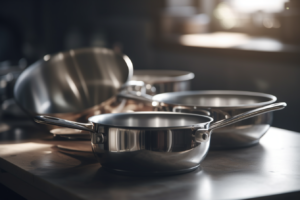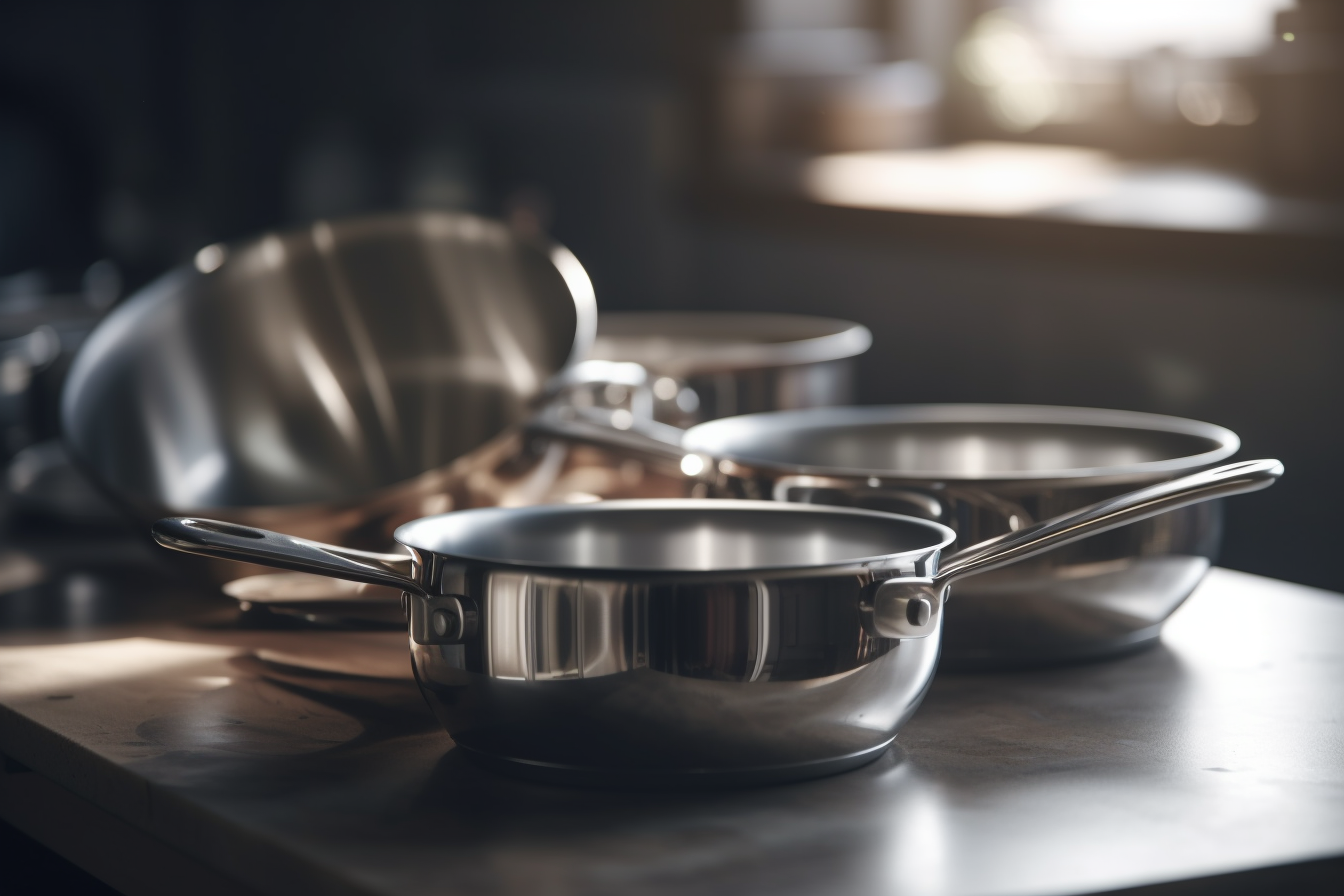The Importance of Cookware

Cookware is an essential tool in any kitchen. It is used for cooking, frying, boiling, and baking. The type of cookware you use can greatly affect the outcome of your dishes. Not all cookware is created equal, and some materials are better suited for certain tasks than others. In this article, we will explore the different types of cookware and their advantages and disadvantages to help you choose the best type for your needs.
Stainless Steel Cookware
Stainless steel cookware is a popular choice due to its durability and versatility. It is corrosion-resistant, non-reactive, and does not leach any harmful chemicals into your food. It also heats up quickly and evenly, making it ideal for searing meats and sautéing vegetables.
One downside of stainless steel cookware is that it can be prone to sticking if not properly seasoned or if the heat is too high. It can also be more expensive than other materials.
Non-Stick Cookware
Non-stick cookware has a coating that prevents food from sticking to it. This makes it ideal for cooking delicate foods like eggs or pancakes without using a lot of oil or butter. Non-stick cookware is also easy to clean and maintain.
However, non-stick coatings can scratch easily, which can cause them to peel over time. They are also not suitable for high-heat cooking as the coating can release harmful chemicals when exposed to temperatures above 500°F.
Cast Iron Cookware
Cast iron cookware has been used for centuries due to its durability and ability to retain heat. It is great for searing meats, frying chicken, and making cornbread or other baked goods. Cast iron skillets are also easy to care for as they don’t require soap or harsh detergents.
One downside of cast iron cookware is that it can be heavy and difficult to maneuver. It also requires regular seasoning to prevent rusting and sticking.
Copper Cookware
Copper cookware is known for its excellent heat conductivity, which allows it to heat up quickly and evenly. It is often used by professional chefs for tasks like making sauces or caramelizing sugar. Copper cookware also has a beautiful appearance that can add a touch of elegance to any kitchen.
However, copper cookware is expensive and requires regular maintenance to keep it looking its best. It also reacts with acidic foods, which can result in a metallic
Advantages and disadvantages of different types of cookware
Non-Stick Cookware
Non-stick cookware is made with a coating that prevents food from sticking to the surface. This makes it easy to clean and requires less oil or butter for cooking. However, non-stick coatings can be easily scratched or damaged, releasing toxic chemicals into your food. They also have a shorter lifespan than other types of cookware.
Stainless Steel Cookware
Stainless steel is durable and resistant to scratches and dents. It heats evenly, making it great for searing meat and cooking sauces. However, stainless steel can be difficult to clean and often requires the use of oil or butter to prevent sticking.
Cast Iron Cookware
Cast iron is known for its ability to retain heat, making it ideal for slow-cooking dishes such as stews and casseroles. It also adds flavor to your food as it seasons over time. However, cast iron is heavy and can be difficult to handle. It also requires seasoning before use and may rust if not properly cared for.
Ceramic Cookware
Ceramic cookware is made from natural materials and is non-reactive, meaning it won’t affect the taste of your food. It’s also easy to clean and comes in a variety of colors and patterns. However, ceramic cookware can be fragile and may crack or break if dropped.
Copper Cookware
Copper heats quickly and evenly, making it great for sautéing vegetables or searing meat. It’s also aesthetically pleasing with its shiny appearance. However, copper is expensive and requires regular polishing to maintain its appearance. It can also react with acidic foods, causing them to become discolored or taste metallic.
Conclusion
In conclusion, each type of cookware has its own advantages and disadvantages. When choosing the best type of cookware for you, consider factors such as ease of cleaning, durability, heat distribution, price point, and personal preference. Ultimately, the best type of cookware is one that you feel comfortable using and that fits your cooking needs.
Stainless steel cookware – Durability and ease of maintenance
Stainless steel is a popular choice for cookware due to its durability and ease of maintenance. It is resistant to scratches, stains, and corrosion, making it a long-lasting option for your kitchen.
One of the biggest advantages of stainless steel cookware is that it is easy to clean. Most pieces are dishwasher safe, but even when handwashing, they require little effort to remove any stuck-on food or residue. This makes them a great choice for busy households where time is limited.
Additionally, stainless steel cookware can go from stovetop to oven without issue. They are also suitable for all stovetops, including induction.
While stainless steel does not have the best heat distribution properties compared to other materials like copper or aluminum, many manufacturers now make tri-ply or multi-ply pots and pans which feature layers of different metals for better heat conductivity.
Overall, stainless steel cookware is a reliable choice that will last you for years with proper care.
Non-stick cookware – Convenience, but potential health concerns
Non-stick cookware is popular because it’s convenient and easy to clean. However, there are concerns about the potential health risks associated with the non-stick coating, which contains a chemical called perfluorooctanoic acid (PFOA) that has been linked to cancer and other health problems.
To minimize your exposure to PFOA, look for non-stick cookware that is labeled as PFOA-free. Also, avoid using metal utensils on non-stick surfaces, as this can scratch and damage the coating. Instead, use silicone or wooden utensils to protect the surface.
If you do decide to use non-stick cookware, it’s important to monitor the condition of the coating and replace it if it becomes scratched or damaged. A damaged coating can release PFOA into your food, increasing your exposure to this potentially harmful chemical.
Overall, while non-stick cookware can be convenient, it’s important to weigh the potential health risks before making a purchase decision.
Cast iron cookware – versatility and durability, but heavy
Cast iron cookware is a popular choice for many home cooks. It is known for its versatility and durability, making it a great investment for any kitchen. Cast iron cookware is made by pouring molten iron into a mold and then allowing it to cool and harden. This process makes the cookware extremely durable and long-lasting.
One of the biggest advantages of cast iron cookware is its versatility. It can be used on the stovetop, in the oven, or even over an open flame. Cast iron skillets are perfect for searing meats and vegetables, while Dutch ovens can be used to make stews, soups, and even bread.
However, one of the downsides of cast iron cookware is its weight. Cast iron can be quite heavy, making it difficult to use for some people. Additionally, cast iron requires a bit more maintenance than other types of cookware. It should be seasoned regularly to prevent rusting.
Despite these drawbacks, many people find that the benefits of cast iron cookware outweigh the negatives. Its versatility and durability make it a great investment that will last for years to come.
Ceramic cookware – non-reactive and easy to clean, but can be fragile
Ceramic cookware is a popular choice for many home cooks. It is non-reactive, which means that it won’t react with acidic foods like tomatoes or vinegar. This makes it a great choice for cooking all kinds of dishes, from stews to sauces to soups.
One of the best things about ceramic cookware is how easy it is to clean. Unlike other types of cookware that can be difficult to scrub clean, ceramic cookware can usually be wiped down with a damp cloth or sponge.
However, ceramic cookware can be fragile and may break if dropped or bumped too hard. It also tends to be more expensive than other types of cookware, so it may not be the best choice for those on a budget.
Conclusion – the best type of cookware depends on personal preference and cooking needs
When it comes to choosing the best type of cookware, there is no one-size-fits-all answer. It ultimately depends on personal preference and cooking needs. Some people may prefer non-stick cookware for easy cleaning, while others may choose cast iron for its durability and versatility.
Those who prioritize health may opt for stainless steel or ceramic, as they are free from harmful chemicals and coatings. Additionally, the type of heat source used should also be considered when selecting cookware.
Ultimately, it’s important to choose cookware that works best for your individual cooking style and needs. By understanding the different types of cookware available, you can make an informed decision that will enhance your cooking experience and produce delicious meals.


